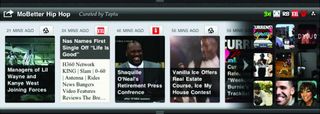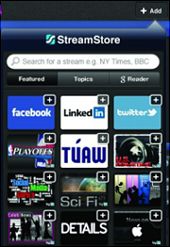Laptop Mag Verdict
Taptu delivers newsfeeds and links from social networks in a single app that also offers good offline support.
Pros
- +
Better offline reading support than competing apps
- +
Integrates well with Facebook and Twitter
- +
Loads content behind social-networking links
Cons
- -
Interface feels somewhat busy
- -
Max of 30 feeds from Google Reader
Why you can trust Laptop Mag
Taptu turns the traditional RSS reader on its head by placing a heavy emphasis on social networking. In addition to providing easy access to your favorite web content, this app lets you add your Facebook, LinkedIn, and Twitter feeds so you're always in the know. Taptu's interface is simple to use, if a bit cluttered, and the app's offline capabilities will appeal to those who spend time reading while disconnected. But can it stand up to the popular Pulse and the fantastic Flipboard?
Interface
Taptu's interface is very similar to Pulse--a grid of uniformly sized cards (news items) arranged in rows (news sources). Each card has an image from the post, a headline, and a tiny icon at the bottom indicating the source and when the story was posted. When there are no images, the thumbnails show as much of the title of the post as will fit. The overall design isn't as attractive as Pulse, but the interface is equally intuitive. The combination of text and images on feed item icons makes it easy to browse posts, but posts without an image looked overly busy.
On Taptu you scroll up and down to see all the sources on a page; scroll left and right within rows to see the different posts and updates. The iOS version of the app allows users to change the height of the rows; panels can grow wider and taller, but never double up on a row. You can also change the border color of rows to make finding your favorites easy.
In the iOS version, there's a smaller mosaic on the far right of each row that offers a tiny thumbnail preview of content going further back in the timeline. On the Facebook and Twitter rows, these thumbnails show profile pictures. The animations are fun to watch, and we liked being able to skip backwards in the item list by tapping the thumbnails.

Click to enlarge
The reading area for a post appears under the row for each source whether the tablet is in portrait or landscape mode. From here users can choose between three font sizes, but not font faces as you can in Zite. A bookmark icon sits on the top right, which places the post in the Saved stream for later viewing. We wish this synced up with a web-based component or at least starred items in Google Reader so we could access saved posts anywhere.
Taptu handles social-networking bookmarks more like Flipboard than Pulse, as it actually loads the content beyond the link. Users can Like and comment on Facebook posts and retweet or reply on Twitter. We also like that in the Twitter stream users see recent activity from the person tweeting and can bring up related tweets.
News Sources

Click to enlargeTaptu lets users add content with the Stream Store, which is a little bit of a misnomer since no money is involved. Just as with Pulse, Taptu has suggested/featured content. Users can also browse sources by topic and add feeds from Google Reader. For social networks, users can add a full Facebook news feed, just Facebook links, LinkedIn updates, and Twitter.
Taptu claims not to be limited to just sites with an RSS feed. Users can add content via keyword search as well. However, this didn't work out very well in our tests. We tried to add our favorite Tumblr blog (getoutoftherecat.tumblr.com) and the literary magazine Strange Horizons via the search function, but Taptu couldn't find either of them.
We like the ability to import from Google Reader, but wish that we didn't have to add each feed individually by tapping the + icon over and over, especially since the app takes a few seconds to process each addition. A "Select All" option would make things much easier.
We also wish that you could create merged streams -- single rows with content from multiple sources -- by just selecting a Google Reader folder. Currently, users have to go into the stream store and create merged streams manually (by dragging and dropping streams on one another).
We also wish that Taptu didn't restrict users to a maximum of 30 feeds from Google Reader in the iPad version. On Android the maximum is 100, but that's still a limitation. Hardcore users will run out of slots fast.
Sharing
Not only can Taptu users share individual items to Facebook, Twitter, and e-mail, but they can also share whole streams as well. Unfortunately, there's no ability to star (save or mark as important) in Google Reader.

Click to enlarge
Offline Use
Taptu offers better offline support than its main competitors. The app will pre-load and cache more than 70 items per feed, sometimes with images. We don't like that users have no control over how many feed items the app downloads and caches. You also don't have the option to cache images as we've seen in NewsRob for Android. Still, we appreciate that Taptu makes a decent amount of content available for commuters and travelers.
Verdict
Taptu has some features that make it stand out from other news readers: It has an intuitive interface, stores content for reading offline, and integrates well with social networks. However, a few key missing features hold it back: The interface isn't as slick as Flipboard or Pulse, and its limit of 30 feeds from Google Reader will frustrate newshounds. But Taptu is a solid choice for those who read from a select list of sites and don't always have Internet access.
Taptu Specs
| Company Website | http://www.taptu.com/ |
| Platforms | Android, iOS |
